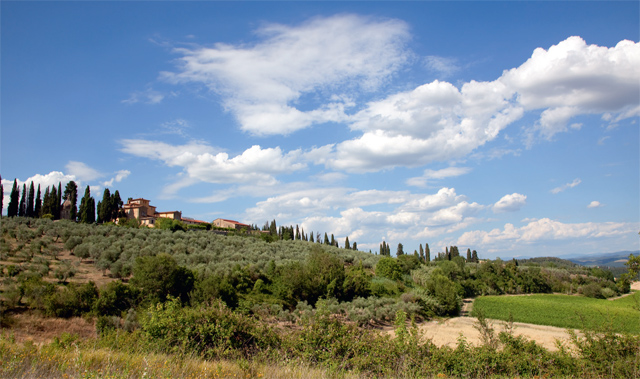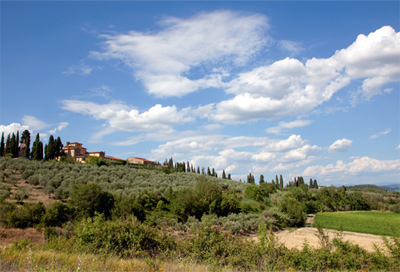Invest in Italian farmland
If you're considering buying farmland for investment, some experts suggest you look further afield than the UK, to Italy


Clive Beer, who heads up Savills rural professional services division, is in a contagiously ebullient mood. ‘Occasionally, in my work, I come across things that are ridiculously exciting,’ he beams. ‘And this is one of them.’ What he’s referring to is an opportunity for British investors to take advantage of various local and EU tax arrangements that mean the option of buying farmland in Italy starts to make serious financial sense.
The self-confessed Italophile is unapologetic in his admiration for the region: ‘If you were to ask me to name a country that seems to use all of its senses to appreciate beauty, from the food and wine to the art and architecture and music, Italy does it best. But what it also does incredibly well is understand the culture of farming.’
The idea of thinking more broadly when it comes to investing in farmland is one of necessity. In the UK today, we have the lowest level of supply of agricultural land coming to the market in years and yet the tax advantages of owning farms when it comes to succession planning— agricultural relief being the major draw—mean that investors are keener than ever to buy into this sector.
But why not be more inventive with your investment, asks Mr Beer? ‘Yes, you can buy 1,000 acres of an East Anglian fen and sit back and know that it will grow and be advantageous for your tax planning, but buying farmland in Italy isn’t just about feeding the wallet, but also the soul at the same time.’ According to Georgia Catarame of Withers worldwide, agricultural relief has been available on property across the European Economic Area since April 2009, which means that, potentially, after two years, the relief could apply.
What’s making this kind of investment more attractive today is that, from August 17 next year, a new EU succession regulation is due to come into effect that will mean a British national will be able to elect to have English law apply to all of their estate, including any Italian farmland, thus avoiding Italian forced heirship rules from coming into play. Another factor focusing the mind is that the Italian government is predisposed to treat an agricultural entrepreneur favourably when it comes to local taxes. ‘And that’s interesting because, notwithstanding the recession, almost all taxes in Italy have gone up recently and yet they’ve let these benefits stand,’ adds Miss Catarame.
But she cautions against simply buying up the first piece of farmland available. ‘We’ve helped a number of clients who are interested in investing in agricultural land in Italy recently—they also want the lifestyle and that’s where it gets more complex. If you want to benefit from all aspects, you might need the house, the land and an agriturismo business and, for all that to work, you need the right people on the ground.’

Royal connections: this 700- acre estate near San Gimignano in Tuscany was once owned by the Italian royal family. It includes a 16thcentury villa, an agriturismo and farms producing wine and olive oil. €35 million through Winkworth International (020–7870 7181
Sign up for the Country Life Newsletter
Exquisite houses, the beauty of Nature, and how to get the most from your life, straight to your inbox.
What it costs
Italian farmland has increased in value from about €1,100 per hectare in 1960 to just over €20,000 per hectare in 2012, although it varies widely from region to region. That’s nothing like the growth in English farmland over the same period, but experts believe that the future for growth is strong, particularly with larger farms, and the sector has proved resilient compared to others during the recession: residential property has fallen by 5.4% in value since 2007, farmland has increased by 1.9%. ‘It’s a bit of a contrarian view, but the more we looked at this option, the more powerful it became,’ explains Mr Beer. ‘The marriage value between the potential in the marketplace and what can be achieved through tax laws makes an extremely efficient investment in terms of capital growth, income and wealth protection. And we’re all slightly in love with Italy. What’s not to like?’
Where to buy
Tuscany seems to come out top for two reasons: it’s dominated by the highest-value crops (olive orchards and vineyards) and is the most popular area for agriturismo in the entire country— according to Italy’s national institute of statistics (ISTAT), 20% of all farm-stay business takes place in Tuscany, followed by the Italian Alps and Lombardy.
Need to know * Italian agriculture represents 17% of the country’s Gross Domestic Product * 90% of farms are smaller than 20 hectares (50 acres) * A hectare of vineyard will produce some 6,000 bottles of wine * Average price per hectare is just over €20,000
Contacts: Clive Beer, Savills (020–7877 4724); Georgia Catarame, Withersworldwide (020–7597 6490)
* Search properties for sale in Italy
** This article was first published in Country Life magazine on July 30 2014
-
 Diamonds are everyone's best friend: The enduring appeal of one of Nature's sparkliest treasures
Diamonds are everyone's best friend: The enduring appeal of one of Nature's sparkliest treasuresEvery diamond has a story to tell and each of us deserves to fall in love with one.
By Jonathan Self Published
-
 Hidden excellence in a £7.5 million north London home
Hidden excellence in a £7.5 million north London homeBehind the traditional façades of Provost Road, you will find something very special.
By James Fisher Published
